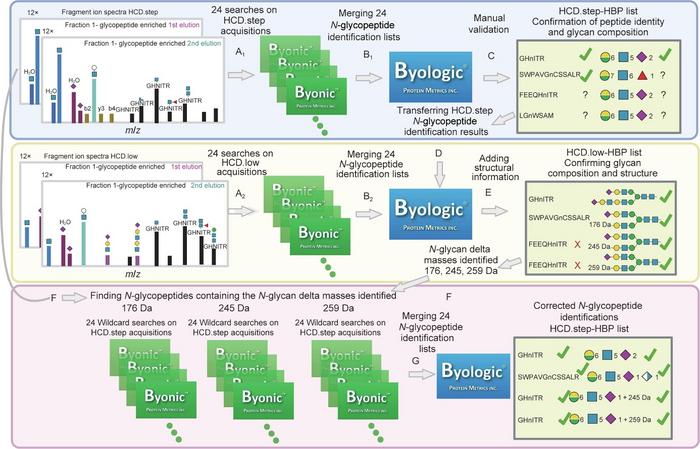A recent breakthrough in the field of proteomics has illuminated the intricate dynamics of human blood plasma (HBP) through a refined analytical technique targeting the low-abundant N-glycoproteome. This innovative approach, detailed in the journal Engineering, promises to enhance the discovery of potential biomarkers that could revolutionize clinical diagnostics and disease monitoring. The study is pivotal for understanding the glycosylation of proteins, a post-translational modification that significantly affects protein function and interaction within biological systems.
Traditionally, protein glycosylation has emerged as a crucial element in the development of novel diagnostic tools and therapeutic agents. However, researchers have long grappled with the limitations of existing N-glycoproteomic methodologies, particularly in complex biological matrices such as blood plasma. The frequent inaccuracies in glycopeptide identification, coupled with the challenges of detecting trace levels of modified N-glycans, have stymied progress in biomarker discovery. The recent research endeavors to address these deficiencies by implementing a sophisticated workflow designed to enhance the resolution and reliability of glycoproteomic analyses.
To tackle the issue of high-abundance proteins, the study initiates a meticulous depletion process targeting the top fourteen proteins that typically overshadow low-abundance glycoproteins in blood plasma samples. This step is critical as it allows for a more nuanced analysis of the proteins that may hold elusive biomarkers. Following this depletion, the workflow integrates a fractionation strategy along with tryptic digestion to further refine the sample pool, setting the stage for a comprehensive exploration of the remaining glycoproteins.
The enriched glycopeptides undergo rigorous high-resolution mass spectrometry analysis utilizing a dual fragmentation approach—stepped collision energy fragmentation (HCD.step and HCD.low). This innovative technique not only enhances the detection of glycopeptides but also provides a more detailed structural characterization. A new decision tree methodology was incorporated into the data validation process, allowing for more accurate and systematic identification of glycopeptides, thus overcoming previous hurdles in the analysis.
Impressive results emerged from the experimental workflow, as it achieved a detection sensitivity that could identify glycoproteins at concentrations as low as 6.31 pg·mL−1. This remarkable improvement represents an expansion of detection capability by an astounding five orders of magnitude compared to conventional plasma analysis methods. Such sensitivity is crucial when considering the rarity of many potential biomarkers, which often exist at extremely low concentrations within biological samples.
The comprehensive data analysis methodology employed in the study further distinguishes ambiguous N-glycan structures which foundationally enriches the understanding of glycosylation patterns. This precision enables researchers to differentiate between various glycan modifications, including antenna and core fucosylation, as well as to recognize rare entities such as sulfated and glucuronidated glycans that were previously unnoticed in routine analyses. These advancements in glycan structural analysis herald a new era in glycoproteomics, facilitating targeted studies for biomarker validation.
In total, researchers successfully identified 1929 unique N-glycopeptides along with 942 N-glycosites sourced from 805 glycoproteins deemed middle- to low-abundant. Among the significant findings, sulfated and phosphorylated N-glycopeptides were detected in prevalent HBP glycoproteins, underscoring the potential of this workflow to uncover novel glycosylation variants that could be critically relevant to health and disease states. Moreover, the study reported the discovery of three rare N-glycan building blocks identified by exact mass measurements of 176.0314, 245.0524, and 259.0672 Da—components that may play pivotal roles in cellular signaling and disease mechanisms.
The implications of this advanced workflow reach far beyond the confines of academic research. Its applicability spans various domains, from identifying novel biomarkers pertinent to disease stratification and prognosis to enhancing the characterization of biotherapeutic proteins in drug development processes. Despite the limitations noted in the study, such as extended measurement times inherent to the instrumentation used, the findings serve as a formidable foundation for future glycoproteomic investigations.
In conclusion, the innovative analysis workflow developed in this study opens new avenues for exploring the low-abundant N-glycoproteome in human blood plasma. As the understanding of protein glycosylation continues to evolve, this research paves the way for significant advancements in identifying biomarkers with the potential to revolutionize diagnostics. A deeper exploration of the glycoproteomic landscape promises to improve our comprehension of disease and health, thereby enhancing the clinical relevance of glycoproteomic studies.
Subject of Research: N-glycoproteomic analysis in human blood plasma
Article Title: New Avenues for Human Blood Plasma Biomarker Discovery via Improved In-Depth Analysis of the Low-Abundant N–glycoproteome
News Publication Date: 1-Feb-2025
Web References: https://doi.org/10.1016/j.eng.2024.11.039
References: N/A
Image Credits: Credit: Frania J. Zuniga-Banuelos et al.
Keywords
Blood plasma, Biomarkers, Proteomic analysis, Clinical research
Tags: biomarker discovery challengesblood plasma biomarkersclinical diagnostics innovationglycopeptide identification accuracyglycosylation of proteinshigh-abundance protein depletionlow-abundance glycoproteinsN-glycoproteome analysisprotein modification impactproteomics breakthroughsophisticated analytical techniquestherapeutic agents development





